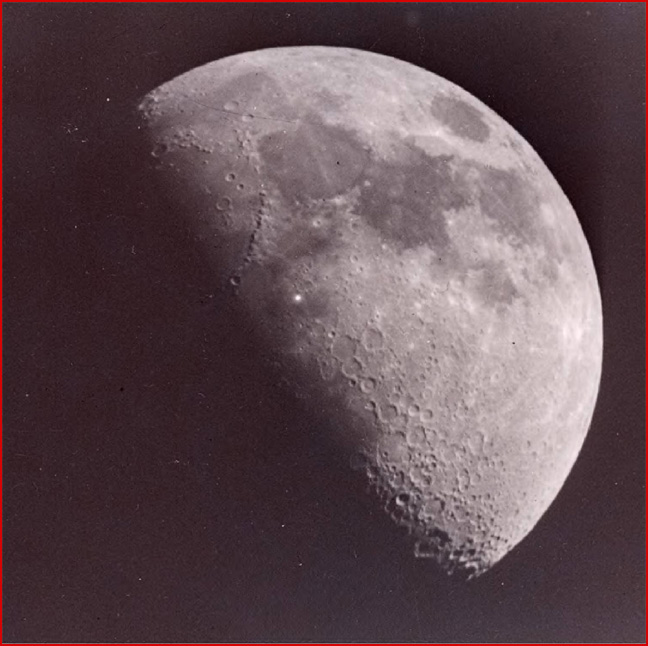
home •
about •
essential guide •
picture of the day •
thunderblogs •
news •
multimedia •
predictions •
products •
get involved •
contact
picture of the day archive subject index
Image of an anomalous bright patch in Mare Vaporum. Credit: Leon Stuart.
Dec 21, 2007
Transient Lunar PhenomenaThe Moon is dominated by gigantic circular structures where unusual luminous discharges have been observed. Are they indicative of past electrical events?
Human beings have long looked up at and wondered about the Moon. Our forebears probably pondered its origin and its influence, perhaps seeking a purpose for the pale, shining orb that now dominates the night sky.
For more than a thousand years, reports have circulated about events on the Moon that should not appear on a "dead" celestial body. Various accounts describe glowing clouds in red and green, or sudden outbursts of yellow flares and intense flashes of light. Such observations do not accord with conventional theories.
Because the Moon is thought to have lost all its heat to space more than a billion years ago and it has no magnetic field to speak of, violent activity should not be taking place on its surface today. For this reason, astronomers and astrophysicists have discounted "transient lunar phenomena". Since most of the sightings by single individuals received no corroboration and no images were recorded until recently, the incidents were said to be apocryphal or deliberately misleading. However, some serious attempts have been made to link historical narratives with physical impacts:
"There was a bright new moon, and as usual in that phase its horns were tilted toward the east; and suddenly the upper horn split in two. From the midpoint of this division a flaming torch sprang up, spewing out, over a considerable distance, fire, hot coals, and sparks. Meanwhile the body of the moon which was below writhed, as it were, in anxiety, and, to put it in the words of those who reported it to me and saw it with their own eyes, the moon throbbed like a wounded snake. Afterwards it resumed its proper state. This phenomenon was repeated a dozen times or more, the flame assuming various twisting shapes at random and then returning to normal. Then after these transformations the moon from horn to horn, that is along its whole length, took on a blackish appearance." (Jack B. Hartung (1976). "Was the Formation of a 20-km Diameter Impact Crater on the Moon Observed on June 18, 1178?" Meteoritics 11:187-194).
Meteors are one hypothesis for the abrupt appearance and disappearance of lunar scintillations, although Hartung's proposal has met with skepticism.
Another consideration is that radiant lunar displays do not originate with the Moon. It is reasonable to assume that unfavorable conditions could result in false impressions. Earth's atmosphere is notorious for distorting the images from ground-based telescopes, so some reflective or refractive discrepancy might intrude into the data. Equipment resolution or the visual acuity of eyewitnesses could also be factors if the observations occur near the limit of crisp apprehension.
Because some TLP's are said to shimmer like a wavering candle, investigators suggest that the Moon has pockets of gas trapped just below the surface. Moonquakes or landslides might cause one of the cavities to rupture, allowing the escaping gas to jet out into the sunlight where it is seen as a hazy column of brightness against the dark regolith.
The majority of such "flames" are associated with the edges of lunar maria which geologists think are ancient volcanic regions. In the image at the top of the page is one of the first photographs of a TLP from within the "Sea of Vapors". The Ina Structure is another area where explosive outgassing is supposed to have taken place, but standard theories place its age at over three million years so its influence on modern accounts is suspect.
That leaves open the question of whether transient phenomena on the Moon are in fact real. The question was answered by a recent statistical breakdown indicating the evidence for them and the reports about them are authentic. What could the explanation be for their appearance?
One theory that bears close examination is related to electrostatic charging and discharging of materials on the surface. Triboelectric charging of particles or electrostatic levitation of dust near the lunar terminator might give rise to some luminescence visible to observers on our planet. Several lunar surface features seem best identified with electrical scars from catastrophic encounters in the recent past, so remnant electrodynamic forces might linger in the Moon's environment to this day - especially since the Moon's orbit takes it in and out of the charge sheath that extends outward from Earth.
Further fascinating reading from Ralph Juergens about the electrical interactions between the Moon and other planetary bodies in the past can be found in the Kronia.com library.
By Stephen Smith
___________________________________________________________________________Please visit our Forum
The Electric Sky and The Electric Universe available now!

|
|

|
EXECUTIVE EDITORS:
David Talbott, Wallace Thornhill
MANAGING EDITORS:
Steve Smith, Mel Acheson
CONTRIBUTING EDITORS: Michael Armstrong, Dwardu Cardona,
Ev Cochrane,
C.J. Ransom, Don Scott, Rens van der Sluijs, Ian Tresman
WEBMASTER: Brian Talbott
Copyright 2007: thunderbolts.info
![]()
home •
thunderblogs •
forum •
picture of the day •
resources •
team •
updates •
contact us

